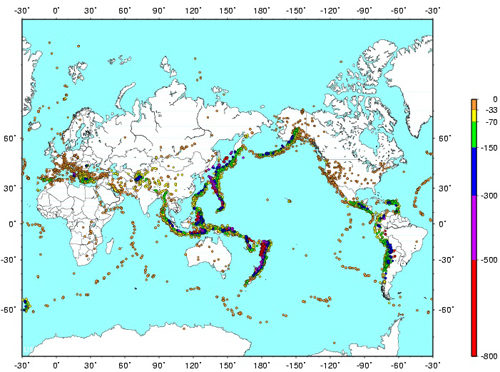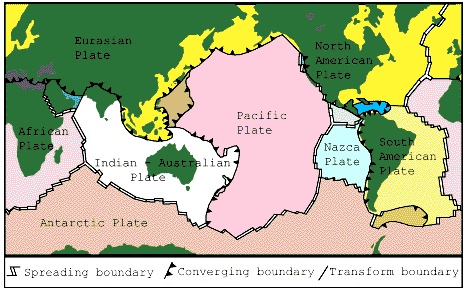The theory of plate tectonics makes two mathematical assumptions:
- The Earth is a sphere.
- Plates are rigid, except at their boundaries.
In fact, the Earth is not a perfect sphere; it bulges at the equator a bit. The second assumption is also not quite true. If plates were perfectly rigid in their interiors, then earthquakes could only happen at plate boundaries. Nearly all earthquakes (98%+) do happen at the plate boundaries, but there are some anomalous events, called intraplate earthquakes, that happen far from the boundaries.
The map below shows earthquake locations around the world for a six-month period. Compare it to the plate boundary map below it and you will see that earthquakes roughly define the plate boundaries. Focus on the North American plate. It is bounded on the west at the edge of the continent and on the east by the Mid-Atlantic Ridge. The East Coast and the central United States are quite far away from any plate boundaries, yet you may notice a fair amount of seismicity locating there. Seismologists are interested in these earthquakes because plate tectonics doesn't explain their existence very well.


Video: Why Intraplate Seismicity (1:04)
PRESENTER: Appear on top is a map that I made with data from the National Earthquake Information Center. It's six months of global seismicity. And down here is a map of plate boundaries in the world.
I hope you'll agree with me that earthquake locations are pretty good at telling you where the plate boundaries are. But let's look at North America for a second. Down here on this map on the bottom, you'll see that there's a plate boundary on the western edge of North America. And then here is a plate boundary. This is the mid-Atlantic ridge. There's a little plate boundary down here.
But if you look up at the top, you'll see a lot of shallow seismicity that locates far away from any of those plate boundaries. Specifically, here's the new [INAUDIBLE] seismic zone right there.
Now, scientists are interested in intraplate earthquakes because the theory of plate tectonics doesn't really explain them very well. And the reading assignment further down this page will allow you to check out three different hypotheses for why these earthquakes happened.
Reading Assignment
Why do earthquakes happen in the center of the continent? Different scientists have different favorite explanations. Below are three scientific papers that each present a different hypothesis to explain why the New Madrid Seismic Zone is seismically active. I have also included three companion articles written for the popular press. For this activity, you will read the articles. You don't need to turn anything in, but you will want to internalize the main arguments of each hypothesis in order to include this information in your fact sheet paper (the culminating assignment for this lesson).
Directions
Read each of the following popular press articles and scientific papers. Keep track of any points made in the scientific papers that you don't understand so you can ask about them. There's no formal graded discussion of these papers, but feel free to post comments/questions in the Questions discussion forum. My suggestion is to read the companion popular press article in each set first so that you are already familiar with the main points of the hypothesis before tackling the scientific paper.
- Hypothesis I: Glacial rebound
- Do Old Glaciers Cause New Earthquakes In New Madrid, Missouri? (26 March 2001).ScienceDaily. Retrieved April 22, 2008, from http://www.sciencedaily.com/releases/2001/03/010309080443.htm.
- Grollimund, B., & Zoback, M. D. (2001). Did deglaciation trigger intraplate seismicity in the New Madrid seismic zone? Geology, 29(2), 175–178.
- Hypothesis II: Mantle Convection
- Lloyd, Robin. Source of Major Quakes Discovered Beneath U.S. Heartland (02 May 2007). LiveScience. Retrieved 09 September 2008 from http://www.livescience.com/environment/070502_newmadrid_quake.html
- Forte, A. M., Mitrovica, J. X., Moucha, R., Simmons, N. A., & Grand, S. P. (2007). Descent of the ancient Farallon slab drives localized mantle flow below the New Madrid seismic zone. Geophysical Research Letters, 34(4).
- Hypothesis III: Ancient Failed Rift (this one is probably the most popular)
- Johnston, A. C., & Kanter, L. R. (1990). Earthquakes in stable continental crust. Scientific American, 262(3), 42–49.
- Braile, L. W., Keller, G. R., Hinze, W. J., & Lidiak, E. G. (1982). An ancient rift complex and its relation to contemporary seismicity in the New Madrid seismic zone. Tectonics, 1(2), 225–237.
- What does the glacial rebound hypothesis predict regarding future seismicity at New Madrid? What about the other two hypotheses?
- What is the Farallon slab? Where did it come from? How do we know where it is? Why does it have an effect on the crust above it?
- What is a failed rift? Are there any places on the globe today where a rift might be failing?
- What is the evidence for and against each hypothesis? Could they all be true or do any of them exclude the possibilities of the others being correct? Which hypothesis seems most plausible to you and why?
- Can you suggest some studies that would help refine any of these three hypotheses or rule any of them out?
In the next part of this lesson, you will analyze seismic data and learn how to estimate earthquake recurrence times with seismicity catalogs. Then you'll read some scientific articles that detail the other ways recurrence intervals can be estimated. You will have to synthesize the uncertainties and limitations inherent with each method in order to get the complete picture of how earthquake risk is determined.
